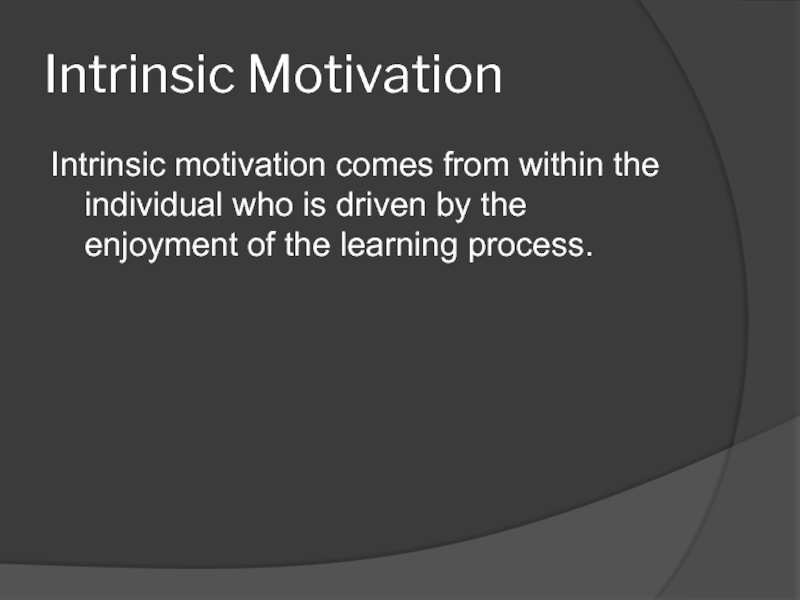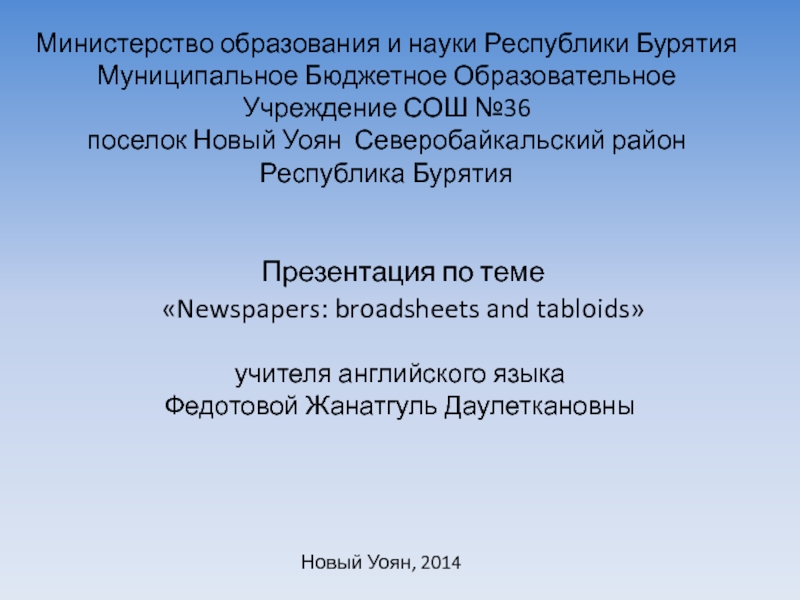MODERN METHODS OF TEACHING ENGLISH: MOTIVATION AND TYPES OF LEARNING
- Главная
- Разное
- Дизайн
- Бизнес и предпринимательство
- Аналитика
- Образование
- Развлечения
- Красота и здоровье
- Финансы
- Государство
- Путешествия
- Спорт
- Недвижимость
- Армия
- Графика
- Культурология
- Еда и кулинария
- Лингвистика
- Английский язык
- Астрономия
- Алгебра
- Биология
- География
- Детские презентации
- Информатика
- История
- Литература
- Маркетинг
- Математика
- Медицина
- Менеджмент
- Музыка
- МХК
- Немецкий язык
- ОБЖ
- Обществознание
- Окружающий мир
- Педагогика
- Русский язык
- Технология
- Физика
- Философия
- Химия
- Шаблоны, картинки для презентаций
- Экология
- Экономика
- Юриспруденция
Modern methods of teaching english motivaton and types of learners презентация
Содержание
- 1. Modern methods of teaching english motivaton and types of learners
- 2. Three major steps of TFL the process
- 3. The success of the process of teaching
- 4. Motivation Motivation, as a key factor in
- 5. Extrinsic Motivation Extrinsic motivation to learn a
- 6. Intrinsic Motivation Intrinsic motivation comes from within
- 7. IntegrativeMotivation Integrative motivation involves the desire to
- 8. Instrumental Motivation Instrumental motivation is the wish
- 9. Global Motivation Global motivation is defined as
- 10. Situational Motivation Situational motivation is the motivation
- 11. Task Motivation Task motivation concerns the way
- 12. The Major Sources of Motivation The major
- 13. LEARNING STYLES OF STUDENTS Appropriately selected tasks
- 14. TYPES OF LEARNERS According to learning styles,
- 15. Visual Learners Visual learners learn better when
- 16. Auditory Learners Auditory learners
- 17. KINAESTHETIC LEARNERS It's likely that you
- 18. LOGICAL LEARNERS Mathematical logical learning style is
- 19. VERBAL LEARNERS Linguistic intelligence or verbal this
Слайд 1PRESENTED BY ASSOCIATE PROFESSOR OF THE DEPARTMENT OF FL FOR HUMANITIES A.
L. ARTSYSHEVSKA
Слайд 2Three major steps of TFL
the process of teaching a foreign language
is a complex one. It usually involves
three major steps:
the teaching acts of presenting
and explaining new material,
providing practice and testing.
three major steps:
the teaching acts of presenting
and explaining new material,
providing practice and testing.
Слайд 3The success of the process of teaching and
learning largely depends on
the participants – teachers and students – who have their own needs, roles, and responsibilities.
It is teachers’ responsibility to
identify and address the needs of their students.
It is teachers’ responsibility to
identify and address the needs of their students.
Слайд 4Motivation
Motivation, as a key factor in the process of learning and
teaching, is defined as some kind of internal drive which pushes someone to do things in order to
achieve something.
Harmer, ( 2001, 51). Ur (1997, 276)
presents the following kinds of motivation:
extrinsic, intrinsic, integrative, instrumental, global, situational and task motivation.
achieve something.
Harmer, ( 2001, 51). Ur (1997, 276)
presents the following kinds of motivation:
extrinsic, intrinsic, integrative, instrumental, global, situational and task motivation.
Слайд 5Extrinsic Motivation
Extrinsic motivation
to learn a foreign language is caused by a
number of outside factors such as the desire to pass an examination
or the possibility of future travel.
or the possibility of future travel.
Слайд 6Intrinsic Motivation
Intrinsic motivation comes from within the individual who is driven
by the enjoyment of the learning process.
Слайд 7IntegrativeMotivation
Integrative motivation involves the desire to identify with and integrate into
the culture of the language one is studying.
Слайд 8Instrumental Motivation
Instrumental motivation is the wish
to learn the language for purposes
of study or career promotion.
Слайд 9Global Motivation
Global motivation is defined as the overall
orientation of the learner
towards the learning of the foreign language.
Слайд 10Situational Motivation
Situational motivation is the motivation caused by the context of
learning such as classroom or school environment.
Слайд 11Task Motivation
Task motivation concerns the way the learner approaches the specific
task
given by the teacher.
Слайд 12The Major Sources of Motivation
The major sources of motivation
to learn a
foreign language, as pointed out by
Harmer (2001, 52), are the society we live in, attitude
of parents, older siblings, peers, the teacher and the
method used.
Harmer (op. cit., 52) emphasizes the
importance of the teacher, who is a major factor in the
continuance of students’ motivation, and the method
used in the teaching process.
According to Ur (1997,
275), the successful learner is the one who is willing
to tackle tasks and challenges, has confidence in
his/her success, has a need to achieve, to overcome
difficulties and succeed in what he/she is doing, is
ambitious and finds important to succeed in learning
in order to maintain and promote his/her own positive
image, is aware of the goals of learning, invests high
level of effort in learning, and is not discouraged by
setbacks or lack of progress.
Harmer (2001, 52), are the society we live in, attitude
of parents, older siblings, peers, the teacher and the
method used.
Harmer (op. cit., 52) emphasizes the
importance of the teacher, who is a major factor in the
continuance of students’ motivation, and the method
used in the teaching process.
According to Ur (1997,
275), the successful learner is the one who is willing
to tackle tasks and challenges, has confidence in
his/her success, has a need to achieve, to overcome
difficulties and succeed in what he/she is doing, is
ambitious and finds important to succeed in learning
in order to maintain and promote his/her own positive
image, is aware of the goals of learning, invests high
level of effort in learning, and is not discouraged by
setbacks or lack of progress.
Слайд 13LEARNING STYLES OF STUDENTS
Appropriately selected tasks and methods can
generate students’ motivation.
The appeal of methods is extended if methods are selected according to students’ learning styles.
Learning style refers to any individual’s preferred ways of learning. It depends on the student’s personality, including psychological
or cognitive character, sociocultural background and educational experience.
Learning style refers to any individual’s preferred ways of learning. It depends on the student’s personality, including psychological
or cognitive character, sociocultural background and educational experience.
Слайд 14TYPES OF LEARNERS
According to learning styles,
all learners can be divided into
visual,
auditory,
kinaesthetic learners
logical
verbal.
Слайд 15Visual Learners
Visual learners learn better when they can read or
see the
information. They usually have a strong sense of colour, they follow written directions well and use
visualization to remember things, they love to read,
remember quickly and easily what is read, and read
well from picture clues. However, they process auditory
input slowly and are distracted by noise or people
talking in the background. They become impatient
when extensive listening is required. According to
Honey & Mumford (1992), visual learners comprise
65 % of all learners.
visualization to remember things, they love to read,
remember quickly and easily what is read, and read
well from picture clues. However, they process auditory
input slowly and are distracted by noise or people
talking in the background. They become impatient
when extensive listening is required. According to
Honey & Mumford (1992), visual learners comprise
65 % of all learners.
Слайд 16Auditory Learners
Auditory learners learn better when the information
primarily comes through their ears. Auditory learners (30% of all learners) tend to remember and repeat ideas that are verbally presented. They learn well through lectures and like to talk to others. They enjoy plays, dialogues, dramas and they like to make speeches and presentations. However, they usually
cannot keep quiet for a longer time.
cannot keep quiet for a longer time.
Слайд 17KINAESTHETIC LEARNERS
It's likely that you use your body and sense
of touch to learn about the world around you. It's likely you like sports and exercise, and other physical activities such as gardening or woodworking. You like to think out issues, ideas and problems while you exercise. You would rather go for a run or walk if something is bothering you, rather than sitting at home.
Слайд 18LOGICAL LEARNERS
Mathematical logical learning style is one of eight types of
learning styles, or intelligences, defined in Howard Gardner's theory of Multiple Intelligences. Mathematical Logical learning style refers to a person's ability to reason, solve problems, and learn using numbers, abstract visual information, and analysis of cause and effect relationships. Mathematical logical learners are typically methodical and think in logical or linear order. They may be adept at solving math problems in their heads and are drawn to logic puzzles and games.
People with mathematical logical learning styles learn best when taught using visual materials, computers, statistical and analytical programs, and hands on projects. They prefer structured, goal-oriented activities that are based on math reasoning rather than less structured, creative activities with inexact learning goals. Mathematical logical learners would find a statistical study more appealing than analyzing literature or keeping a journal.
People with mathematical logical learning styles learn best when taught using visual materials, computers, statistical and analytical programs, and hands on projects. They prefer structured, goal-oriented activities that are based on math reasoning rather than less structured, creative activities with inexact learning goals. Mathematical logical learners would find a statistical study more appealing than analyzing literature or keeping a journal.
Слайд 19VERBAL LEARNERS
Linguistic intelligence or verbal this is where an individual responds
best through auditory methods of teaching. Essentially, this is verbal learning, where a student will learn most efficiently from listening to people and taking in information. It means an individual has an ability to solve complex problems, come to conclusions and learn overall using language alone.
Hence, those who prefer verbal learning will be particularly talented from an early age when it comes to reading and writing. Verbal learners will be able to express themselves, their problems, and solutions to problems through words. Oftentimes, also, they will have particularly good memories, as verbal learning involves taking in a lot of information in short periods of time and retaining it.
Individuals who prefer verbal learning usually also have a fascination with the arts, music and lyrics, legal documents, old-world writings, politics, screenplay and novels. These kinds of learners will also enjoy using language creatively, through fiction and poetry and even through contemporary art in some cases. Linguistic learners appreciate language to be complex and thoroughly interesting, and for any people, one language is not enough. Verbal learners often learn numerous other languages in an effort to increase their knowledge, their wisdom, and their ability to use words to communicate with a larger audience during their lifetime.
Hence, those who prefer verbal learning will be particularly talented from an early age when it comes to reading and writing. Verbal learners will be able to express themselves, their problems, and solutions to problems through words. Oftentimes, also, they will have particularly good memories, as verbal learning involves taking in a lot of information in short periods of time and retaining it.
Individuals who prefer verbal learning usually also have a fascination with the arts, music and lyrics, legal documents, old-world writings, politics, screenplay and novels. These kinds of learners will also enjoy using language creatively, through fiction and poetry and even through contemporary art in some cases. Linguistic learners appreciate language to be complex and thoroughly interesting, and for any people, one language is not enough. Verbal learners often learn numerous other languages in an effort to increase their knowledge, their wisdom, and their ability to use words to communicate with a larger audience during their lifetime.

























